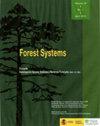哥伦比亚加勒比干旱地区牧场树木生物量的碳储存
IF 0.7
4区 农林科学
Q3 FORESTRY
引用次数: 0
摘要
研究目的:确定牧场中分散树木的碳固存作为温室气体(GHG)缓解措施的重要性。研究领域:该研究于2020年10月至2021年3月在Agustin Codazzi市(哥伦比亚塞萨尔省)进行。材料和方法:我们对分布在16个地块中的43.57公顷进行了表征,并对所有胸径>10厘米的树木进行了测量。异速方程用于估计地上生物量储存,并根据用途对物种进行分类:木材产品(TP)和非木材产品(NTP)。主要结果:共登记树木750株,10科28种,其中NTP和TP分别占60.71%和32.1%。牧场树木的地上碳储量估计为7.15+4.8 Mg C ha-1。最丰富的物种是胡瓜。和Albizia saman(Jacq.)Merr。研究重点:NTP物种具有很高的碳储存潜力,并提供牲畜资产。重视牧场的碳储存可以通过为受威胁物种的碳储存、保护和恢复提供激励来抵消牧场树木的低机会成本。本文章由计算机程序翻译,如有差异,请以英文原文为准。
Carbon storage in tree biomass dispersed in pastures in the arid Caribbean region of Colombia
Aim of study: To determine the importance in terms of carbon sequestration of dispersed trees in pasture lands as a greenhouse gas (GHG) mitigation measure.
Area of study: The study was carried out in the municipality of Agustin Codazzi (Cesar Department, Colombia), between October 2020 and March 2021.
Material and methods: We characterized 43.57 hectares dispersed amongst sixteen plots and all trees with a diameter at breast height > 10 cm were measured. Allometric equations were used to estimate aboveground biomass storage and species were classified in terms of use: timber products (TP) and non-timber products (NTP).
Main results: A total of 750 trees were registered, 10 families and 28 species, of which NTP and TP represented 60.71% and 32.1% respectively. Aboveground carbon stock in trees in pastures was estimated at 7.15 + 4.8 Mg C ha-1. The most abundant species were Guazuma ulmifolia Lam. and Albizia saman (Jacq.) Merr.
Research highlights: NTP species present a high potential for carbon storage and provide livestock assets. Placing value on carbon storage in rangelands can offset the low opportunity cost of trees in pastures by providing incentives for carbon storage, conservation, and recovery of threatened species.
求助全文
通过发布文献求助,成功后即可免费获取论文全文。
去求助
来源期刊

Forest Systems
FORESTRY-
CiteScore
1.40
自引率
14.30%
发文量
30
审稿时长
6-12 weeks
期刊介绍:
Forest Systems is an international peer-reviewed journal. The main aim of Forest Systems is to integrate multidisciplinary research with forest management in complex systems with different social and ecological background
 求助内容:
求助内容: 应助结果提醒方式:
应助结果提醒方式:


